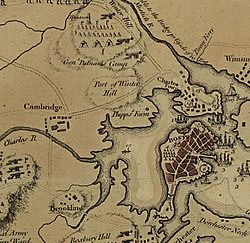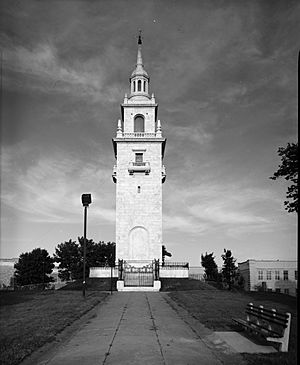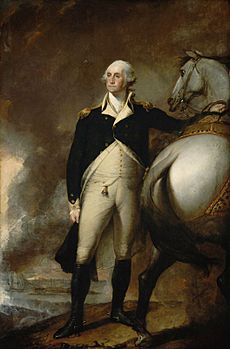Fortification of Dorchester Heights facts for kids
Quick facts for kids Fortification of Dorchester Heights |
|||||||
|---|---|---|---|---|---|---|---|
| Part of the American Revolutionary War | |||||||
 A 1775 map of Boston, showing Dorchester Heights at the bottom right |
|||||||
|
|||||||
| Belligerents | |||||||
| Commanders and leaders | |||||||
| Strength | |||||||
| 2,000–6,000 on Dorchester Heights | 10,000 in Boston | ||||||
The Fortification of Dorchester Heights was a very important event early in the American Revolutionary War. It led to the end of the siege of Boston and made British soldiers leave the city.
On March 4, 1776, soldiers from the Continental Army, led by George Washington, took over Dorchester Heights. These were low hills that offered a great view of Boston and its harbor. The American soldiers quickly set up powerful cannons there. These cannons could threaten the city and the British Navy ships in the harbor.
General William Howe, who commanded the British forces in Boston, planned to attack and remove the Americans. However, a big snowstorm stopped his attack. Instead, General Howe decided to leave. British soldiers, along with Loyalists (people who supported the British King), left Boston on March 17. They sailed away to Halifax, Nova Scotia.
Contents
Why Dorchester Heights Was Important
The siege of Boston started on April 19, 1775. After the Battles of Lexington and Concord, American militia (citizen soldiers) surrounded Boston. The British army was trapped inside the city.
An American officer named Benedict Arnold suggested capturing Fort Ticonderoga in New York. He knew it had many cannons and military supplies that the Americans needed. On May 10, Arnold, along with Ethan Allen and his Green Mountain Boys, successfully captured the fort and all its weapons.
After George Washington took command of the American army in July 1775, he heard about the cannons at Ticonderoga. Colonel Henry Knox suggested bringing these heavy cannons to Boston. Washington gave Knox the difficult job of moving them.
Knox went to Ticonderoga in November 1775. Over three winter months, he moved 60 tons of cannons and other weapons. He used boats, horses, ox-drawn sleds, and even manpower. They traveled along bad roads, crossed two partly frozen rivers, and went through forests. This amazing journey is called the "Noble Train of Artillery." Historians say it was one of the greatest supply efforts of the entire war.
The Plan to Take the Heights
The British military leaders, especially General William Howe, knew how important Dorchester Heights was. These hills, along with those in Charlestown, overlooked Boston and its harbor. The harbor was very important for the British Navy to protect soldiers and bring supplies.
Early in the siege, the British had planned to take these hills. But their plan was leaked, which led to the Battle of Bunker Hill. Neither the British nor the Americans had dared to take and fortify Dorchester Heights. But both armies knew it was a key location.
When Washington took command, he thought about taking Dorchester Heights. But he decided his army wasn't ready for the British attack that would surely follow. In February 1776, the idea came up again. However, the Americans didn't have enough gunpowder or soldiers at that time.
By the end of February, Henry Knox had arrived with the cannons from Ticonderoga. More gunpowder and shells also arrived. Washington decided the time was right to act.
Building the Fortifications
Washington first placed some of the heavy cannons from Ticonderoga at other locations around Boston. These included Lechmere's Point and Cobble Hill in Cambridge. He ordered these cannons to fire on Boston on the night of March 2. The British fired back, but no one was hurt much. These cannon attacks happened again on March 3. This was a trick to distract the British.
On the night of March 4, 1776, the cannons fired again. But this time, the Americans were also making a big move. While the British were focused on the cannon fire, the Americans began a secret plan. This plan was designed by Rufus Putnam to end the long siege.
The American goal was to get cannons onto Dorchester Heights and build strong defenses there. The ground was frozen, so digging was impossible. Putnam, who used to build mills, came up with a clever idea. They would use "chandeliers" (heavy wooden frames) and "fascines" (bundles of sticks). These were built secretly, away from British eyes.
General John Thomas and about 2,500 soldiers quietly marched to the top of Dorchester Heights. They carried tools, the pre-made fortifications, and cannon parts. Hay bales were placed between the soldiers' path and the harbor. This helped to muffle the sounds of their work.
All night long, these soldiers worked hard. They hauled cannons and built walls overlooking the town and harbor. General Washington was there to encourage them. He reminded them that March 5 was the sixth anniversary of the Boston Massacre. By 4 a.m., they had built defenses strong enough to stop small guns and grapeshot. Work continued, with soldiers cutting trees and building barriers called "abatis" to slow down any British attack. They also had barrels filled with rocks ready to roll down the hill at attacking troops.
"The rebels have done more in one night than my whole army would have done in a month."
Washington expected General Howe to either leave or try to attack the hill. An attack would likely be similar to the Battle of Bunker Hill, which was a disaster for the British. If Howe decided to attack Dorchester Heights, Washington planned to attack Boston from Cambridge. He had boats ready to carry almost 3,000 soldiers for this attack. Washington was right about Howe's choices; these were exactly the options Howe considered.
British Response and Evacuation
Admiral Shuldham, who commanded the British fleet, said that their ships were in danger. He insisted that the Americans must be removed from the heights. Howe and his officers decided to fight for the heights. They planned an attack, preparing to send 2,400 men under the cover of darkness.
Washington learned about the British plans. He quickly sent more soldiers to the heights. Soon, nearly 6,000 American soldiers were ready on Dorchester Heights. However, a snowstorm began late on March 5. This storm stopped any chance of a battle for several days. By the time the storm ended, Howe changed his mind about attacking. He decided it was more important to save his army for other battles than to try and hold Boston.
On March 8, messages were sent to Washington. They said that Boston would not be burned if his troops were allowed to leave peacefully. After several days of preparations and bad weather, the British forces left Boston by sea on March 17. They sailed to Halifax, Nova Scotia. More than 1,000 Loyalist civilians went with them.
What Happened Next

The defenses on Dorchester Heights stayed in place until the end of the war. Then, they were no longer used. During the War of 1812, the heights were fortified again to protect against a possible British invasion. After that war, the defenses were completely abandoned. Later, in the late 1800s, the Dorchester hills were used as a source of dirt to fill in parts of Boston's expanding coastline.
In 1902, people became interested in the local history again. The Dorchester Heights Monument was built on the remaining high ground in what is now South Boston. The large Irish population in the area also helped make March 17 a holiday. This day is Saint Patrick's Day, and it is also called Evacuation Day in Suffolk County, Massachusetts, which includes Boston.
The Dorchester Heights National Historic Site was added to the National Register of Historic Places in 1966. In 1978, it became part of the National Park Service as part of Boston National Historical Park.
See also
 In Spanish: Fortificación de Dorchester Heights para niños
In Spanish: Fortificación de Dorchester Heights para niños


